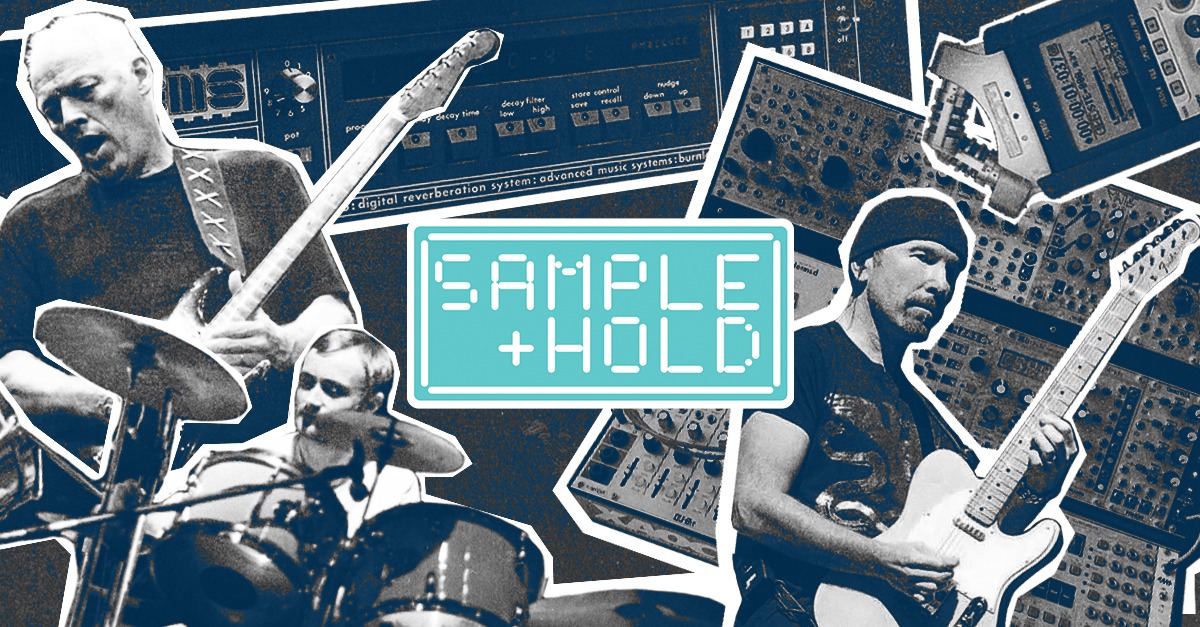
Sample and Hold: Modular Synth, Field Recording and Gated Reverb

Welcome to Sample and Hold, the series on the LANDR Blog where we highlight one unique crate-digging session and the digger’s gold we came back with using Selector—the world’s first AI sample recommendation tool.
Starter Loop: Modular Synth
Today on Sample and Hold I’ll start with modular synth.
After a bit of digging I uncovered this filtered, undulating percussive loop with the signature drippy resonance of a modular rig:
Modular synthesis means that individual parts of a synthesizer like the oscillators, filters and envelopes are arranged as separate components.
To create sounds on a modular you have to make the connections between modules physically using patch cables.
To create sounds on a modular you have to make the connections between modules physically using patch cables.
The learning curve for modular synthesis is steeper than with integrated synths, but the payoff is that the signal routing is limited only by your imagination.
Modular synthesis has been steadily growing in popularity since the introduction of the Eurorack standard in the late 90s.
Before Eurorack, modular synth builders had different conventions for patching, power supplies and module size that prohibited musicians from using modules from different manufacturers in the same rig.
Eurorack standardized those conventions and created a massive boom in the development and adoption of modular synthesis.
Today some of the wildest rigs you can find online belong to hardcore modular enthusiasts.
And with the number of creative Eurorack devices growing by the day, it’s hard not to get sucked into the craze. Get your wallet ready!
Selection 1: Field Recording
Right there in the first few recommendations for the modular loop I found an eerie, realistic soundscape.
There’s no doubt—this is a field recording of a real environment.
Using field recordings in your music is one of our favourite creative techniques at LANDR.
We’ve created a full guide to using them in your workflow and done a rundown of the best field recorders available to capture your own.
There’s something amazing about how a well-rendered soundscape can immediately transport you to a different place.
There’s something amazing about how a well-rendered soundscape can immediately transport you to a different place.
It’s important to remember that real people in real places are the ones listening to your tracks. Actual environmental sounds are one powerful way to acknowledge this in your production.
LANDR Samples has an amazing library of ambience and field recordings—just click on this Selector session to browse through a fraction of what’s out there on the platform.
Don’t get too caught up in them though, there’s always something slightly creepy about eavesdropping on real life as a disembodied listener…
Selection 2: Gated Reverb
On page 3 of the field recording session I found a lively snare with rich gated reverb:
https://samples.landr.com/recommendations/d8bbc4c5-39fc-45e2-aaac-994621d1f684
Gated reverb is one of the signature production techniques from the 80s.
Gated reverb is one of the signature production techniques from the 80s.
Some consider it a cliche, but gated reverb is a fun bit of sound design with a distinctive flavor that can radically change the timbre of some sources.
Here’s how it works. Gated reverb is essentially a combination of a reverb and an expander/gate.
Gated reverb is essentially a combination of a reverb and an expander/gate.
Once the level of a reverb tail drops below the gate’s threshold, the gate will cut the decay off sharply.
The effect is a disorienting unnatural reverb that’s great for emphasizing percussive hits.
The effect was made famous by Phil Collins and Peter Gabriel—almost by accident. Sophisticated 80s studio consoles had dedicated listenback systems for artists to communicate more easily with engineers in the control room.
Since the listenback microphones were often mounted far away from the musicians, these systems needed an aggressive compressor in the chain to bring up the level enough to be heard.
With all that compression the noise floor was naturally much higher. To solve it the engineers implemented a gate that would kick in whenever the artist stopped speaking.
When the engineer accidentally monitored Collins drumming through the listenback system, the gated reverb effect took everyone by surprise
The compressor would bring up the ambience of the room drastically and the gate would cut off the trails much quicker than the natural decay.
This effect became popular enough to be implemented in the newly developed digital reverbs of the time. The most famous of these is the AMS RMX 16, where it was called “Nonlinear.”
The AMS RMX 16s non-linear presets were used on some of the most famous recordings of the 1980s.
Selection 3: Synth Sequence
Finally, on page 3 of the gated reverb sound I found another undulating synth sequence to bring things back to where we started.
There’s no way of telling if this clangy burbling rhythm was created on a modular, but it doesn’t sound too far off.
This sound has a uniquely effective use of rhythmic delay to emphasize the sense of action in the pattern.
The cascading delays multiply the clicky onsets of the synth and spread them around satisfyingly in the stereo field.
This is a classic technique for creating enveloping ambient textures that’s been used by famous delay users like David Gilmour and The Edge.
That’s it for today’s Selector deep dive!
Gear guides, tips, tutorials, inspiration and more—delivered weekly.
Keep up with the LANDR Blog.






